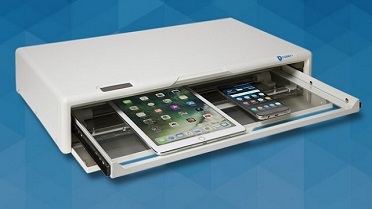 BOTHELL, WASH.—There has been an ‘ick’ factor associated with hotels for a long time. Think TV remotes, shared keyboards, key cards that have touched who knows how many hands, etc. “Ninety-six percent of keyboards have pathogens on them,” says Mark Beeston, VP of Sales and Marketing at Vioguard, a company now offering three solutions that use UV-C, a type of ultraviolet light, for disinfection. “Keyboards are a shared item. Upwards of 40 percent of pathogens transfer.” Think about your own mobile phone. “Ninety-two percent have pathogens on them,” Beeston adds.
BOTHELL, WASH.—There has been an ‘ick’ factor associated with hotels for a long time. Think TV remotes, shared keyboards, key cards that have touched who knows how many hands, etc. “Ninety-six percent of keyboards have pathogens on them,” says Mark Beeston, VP of Sales and Marketing at Vioguard, a company now offering three solutions that use UV-C, a type of ultraviolet light, for disinfection. “Keyboards are a shared item. Upwards of 40 percent of pathogens transfer.” Think about your own mobile phone. “Ninety-two percent have pathogens on them,” Beeston adds.
In a COVID-19 world, it is no longer acceptable for these types of items—tablets is another example—to move from one employee or guest to another without disinfection.
“Vioguard has been around for a few years,” Beeston says. “Our first product was Defender.” The first and only self-sanitizing ultraviolet (UV-C) keyboard and trackpad with FDA clearance, Defender UV-C automatically disinfects the keyboard and trackpad after every use. According to Vioguard, the system is 99.99 percent effective in killing harmful microorganisms within seconds, eliminating the need for manual disinfection and disposal of biohazard waste. Think wipes, gloves, etc. Also eliminated is the chance that cleaning fluid will degrade an item, or the need to let a cleaner sit on an object for several minutes to do its job. The Defender can be mounted under a desk or where most needed.
The second product from Vioguard, Cubby, kills 99.99 percent of the most problematic hospital-acquired infections (HAIs) with 180-degree top down sanitization in under 60 seconds. Cubby destroys germs, bacteria, and viruses at the molecular level. Effectiveness is guaranteed by the patented dosimeter technology that measures the UV-C level to ensure delivery of the precise amount required to destroy these infectious agents. The Cubby uses the same patented technology as the Defender. Unlike the Defender, which is used only for its associated keyboard, Cubby can disinfect the keyboard, mousepad and mouse.
With the Cubby+, one can sanitize small items like TV remotes, cell phones, tablets, key cards, staplers, pens, wallets, name badges, etc.
Beeston says when installed in the lobby of a hotel for guests to use, the Cubby+ can show guests that the hotel really cares about their safety and wellbeing.
More on UV-C Technology
According to Vioguard, studies have shown that most gram-positive and many gram-negative bacteria can live on inanimate surfaces for months. These can include VRE, MRSA, E. coli and several types of strep. There are some viruses that can only survive for days on objects. However, the nastiest, spore-forming pathogens like C. diff can survive up to four months on surfaces.
Ultraviolet light for the use of germicidal irradiation is not a new concept. In fact, it has been used as such since the late 19th to early 20th century. UV-C is a type of ultraviolet light that has wavelengths between 200 to 280 nanometers (nn). Light within those wavelengths can be used for UV-C disinfection. The optimal germicidal wavelength is 254 nm, which is where the Vioguard products operate.
Unlike their resilient response to chemical disinfectants, microorganisms are unable to develop UV-C resistance.
FDA Clearance is the process by which the Food and Drug Administration clears food, drugs, medical devices and other products. In Vioguard’s case, the Food and Drug Administration cleared the UV-C technology used in Defender. It is a rigorous process that can take months or even years. The technology was taken through a series of tests to determine the accuracy at which it killed pathogens. It was determined to have a 99.99 percent kill rate.
Vioguard products are created with lock-tight seals to prevent UV-C light exposure to end users.
Glenn Hasek can be reached at greenlodgingnews@gmail.com.





